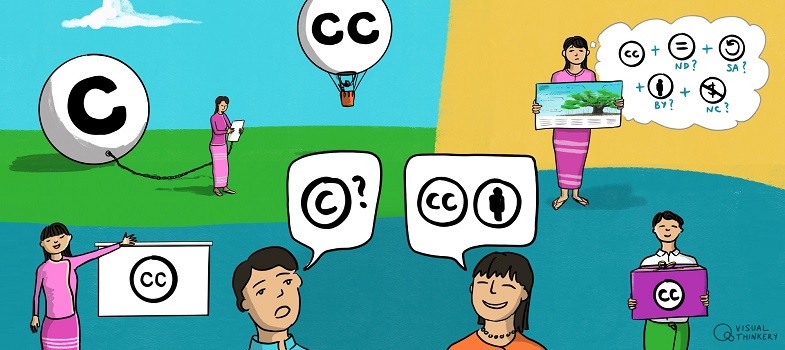Adapting OER
Copying a CC-licensed work and sharing it is straightforward. You must:
- make sure to provide attribution (TASL)
- refrain from using it for commercial purposes if it is licensed with one of the non-commercial (NC) licences.
If a CC licence permits – for example, if it does not contain the no-derivatives (ND) element – then you can also make changes to a resource and share it with others. In Section 5.1 we looked at doing this and how to acknowledge the changes, as well as introducing derivative works.
But incorporating materials created by others and combining materials from different sources can be tricky in terms of both pedagogy and copyright. What do we need to consider if we are changing a CC-licensed work or incorporating it into a new work?
First, remember that if your use of someone else’s CC-licensed work falls under an exception or limitation to copyright (such as fair use or fair dealing), then you have no obligations under the CC licence. If that is not the case, you need to rely on the CC licence for permission to adapt the work.
The threshold question then becomes: is what you are doing creating an adaptation?
Adaptation (or derivative work, as it is called in some parts of the world) is a term of art in copyright law. In Unit 1 we noted that the new Myanmar Copyright Act has not yet defined what is referred to as ‘adaptation’, although this type of work is covered by the new Act. In general, adaptation means creating something new from a copyrighted work that is sufficiently original to itself be protected by copyright. This is not always easy to determine, although some clear lines do exist. Under the new Myanmar Copyright Act, works that change format are considered adaptations and therefore require permission from the copyright holder. You can read more about what constitutes an adaptation in different countries in this explanation from Creative Commons. Some examples of adaptations include a film based on a novel or a translation of a book from one language into another.
Keep in mind that not all changes to a work result in the creation of an adaptation, such as spelling corrections. Also remember that to constitute an adaptation, the resulting work itself must be considered based on or derived from the original. This means that if you use a few lines from a poem to illustrate a poetry technique in an article you’re writing, your article is not an adaptation, because your article is not derived from or based on the poem from which you took a few lines. However, if you rearranged the stanzas in the poem and added new lines, then the resulting work would almost always be considered an adaptation.
As of version 4.0, all CC licences, even the ND or no-derivatives licences, allow anyone to make an adaptation of a CC-licensed work. The difference between the ND licences and the other licences is that if an adaptation of an ND-licensed work has been created, it cannot be shared with others. This allows, for example, an individual user to create adaptations of an ND-licensed work. But ND does not allow the individual to share adaptations with others, including to students at an educational institution.
If your reuse of a CC-licensed work does not create an adaptation, you should note the following points:
- You are not required to apply a licence with a ShareAlike (SA) element in it to your overall work if you are using an SA-licensed work within it. For example, you might be designing a presentation and want to use a CC BY-SA 4.0 photo to illustrate a slide. You are not going to adapt the photo; therefore, the ‘SA’ element of the licence does not impact on the licence type you should choose for your presentation, because the photo remains a discrete entity. We will return to look at this in more detail in our discussion of collections below.
- The ND restriction does not prevent you from using an ND-licensed work. This is because you are not adapting or creating derivatives from the work with an ND licence on it.
- You can combine CC-licensed material that you have not adapted with other work as long as you attribute and comply with the non-commercial (NC) restriction if it applies.
If your reuse of a CC-licensed work does create an adaptation, then there are limits on whether and how you may share the adapted work. We will look at those next. But first, a note about collections of materials.
Adaptations/remixes vs collections
The distinction between adaptations and collections is one of the trickiest concepts in copyright law. While there are many situations in which the differences are clear, there are also several ambiguous scenarios. The distinction between adaptations and remixes varies by jurisdiction and, even within a given jurisdiction, a judge’s determination between the two can be subjective, since there are few definitive rules on which to rely.
In contrast to an adaptation or remix, a collection involves the assembly of separate and independent creative works into a collective whole. A collection is not an adaptation. Let’s use the analogue of food and drink to take a closer look at the difference between adaptations/remixes and collections.
Introduction
